It’s no exaggeration to say that Florida is the invasive species capital of the U.S. There are more than 500 non-native plants and animal species. Invasive species harm the environment, economy, and human health and safety. They are causing significant damage to all of Florida’s habitats – marine, freshwater, and terrestrial.
Invasive Nuisance Wildlife in Southwest Florida
South Florida is uniquely susceptible to invasive species. It has a warm climate, lush landscape, leads the world in the reptile trade, and the exotic pet trade.
One of the most prevalent and destructive invasive species is the Burmese python. It is estimated tens of thousand Burmese pythons live in the Everglades. It is not likely that invasive snake will become a nuisance wildlife problem.
In cities like Fort Myers, Sarasota, and Naples there are invasive species more likely to cause a problem for homeowners and businesses. Animals like armadillos and iguanas commonly cause problems for homeowners in Florida. Wild hogs, cane toads, and tegu lizards can become nuisance wildlife too.
Most Common Invasive Critters in Southwest Florida
Armadillos
Armadillos are one of the most prevalent invasive species in Florida. Introduced in the 1920s, their population quickly spread.
The most common armadillo problem is their proclivity to dig up your yard.
Armadillos pose very little direct threat to people; however, you should still avoid contact. The nine-banded armadillo is the only animal besides humans that can carry the bacteria causing leprosy.
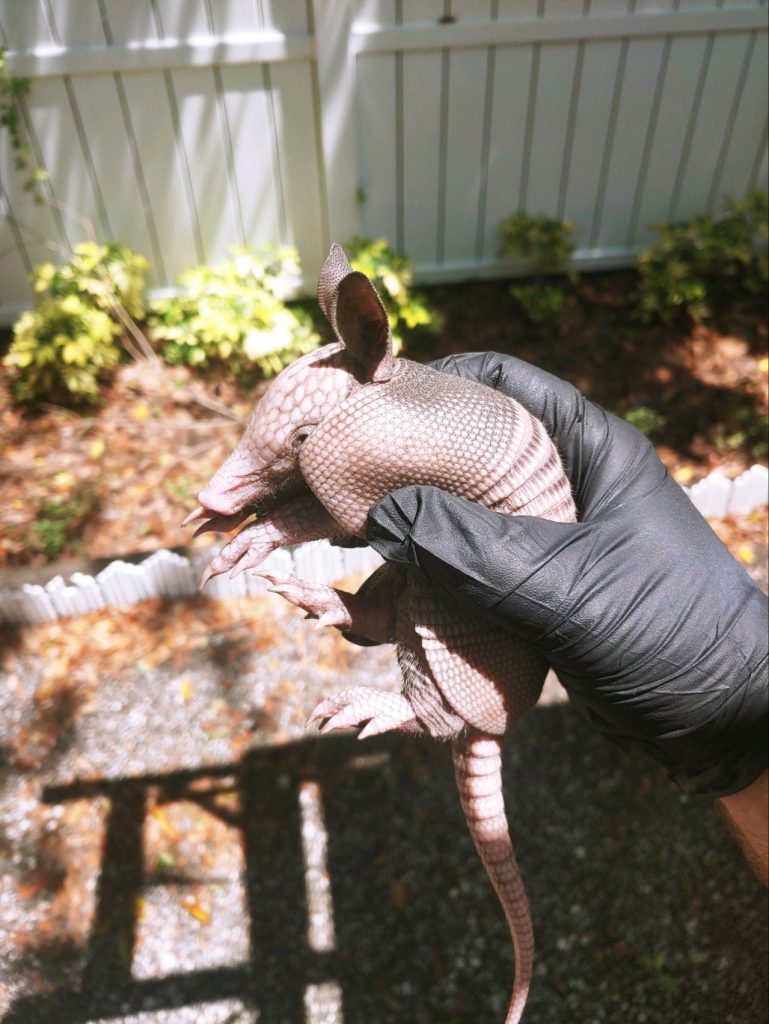
Wild Hogs
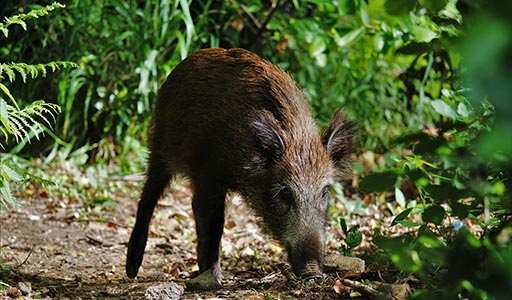
These animals go by a variety of flattering names—feral hog, feral swine, wild boar, wild pig, to name a few. They are large animals, measuring five to six feet long and weighing over 150 pounds. Thought to have been introduced by the Spanish explorer Hernando DeSoto as early as 1539, wild hogs now occupy every county in the state of Florida.
Wild hogs feed by rooting with their large snouts, which can disturb the soil surface and uproot native vegetation. Their wallowing behavior also destroys small ponds and stream banks, which may impact water quality.
They also carry a great many diseases and parasites, including hog cholera, pseudorabies, tuberculosis, salmonellosis, ticks, fleas, and various worms.
In addition to all this, wild hogs can represent a significant physical danger if they’re injured or cornered. Weighing up to 200 pounds, they are capable of great speed, and can cause serious damage with their tusks.
For the above reasons, and because they are prolific breeders that appear nearly impossible to eradicate, wild hogs are a popular target for hunters. They may be hunted or trapped year-round in Florida without a hunting license, but landowner permission is a necessity.
Green Iguanas
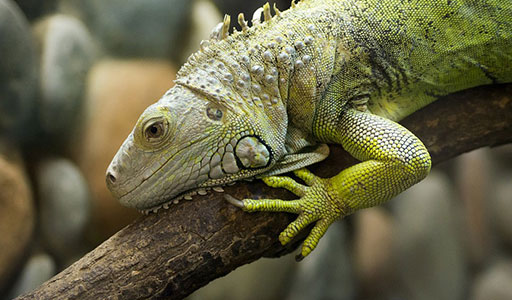
These large, prehistoric-looking lizards are native to Central America, but were first reported in Florida in the 1960s in Hialeah, Coral Gables, and Key Biscayne along Miami-Dade county’s southeastern coast.
While they may look stunning, green iguanas are not a benign presence. They are attracted to a large number of commercial and residential plants:
- trees with foliage or flowers
- most fruits (except citrus)
- virtually any vegetable
They can also damage infrastructure by digging burrows that erode and collapse sidewalks, foundations, seawalls, and canal banks.
Although they are primarily herbivores, researchers have discovered the remains of native tree snails in the stomachs of green iguanas, suggesting that they could be a threat to the imperiled species. Additionally, iguanas can transmit salmonella to humans through contact with water or surfaces contaminated by their feces.
Like the other invasive species on this list, green iguanas can be humanely killed year-round on private property with landowner permission.
Cane Toads
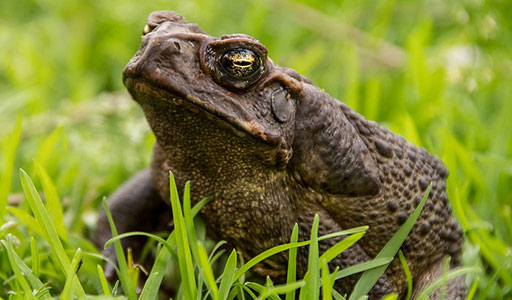
The cane toad or Buffalo toad is a large, nonnative amphibian that was first introduced to Florida to control agricultural pests in sugar cane in the 1930s. It is believed that current populations are the result of escapes and releases by importers in the 1950s and 60s.
The cane toad is often confused for the native southern toad, however, adult cane toads—at six to nine inches in length—are considerably larger than southern toads, which rarely grow beyond four inches.
Ever since they were brought into Florida from their native range in the Amazon basin north to the Rio Grande in Texas, cane toads have significantly affected both pets and wildlife in south Florida.
These toads secrete a toxin called bufotoxin through their skin, which can sicken or even kill animals that try to bite or eat them, which includes native animals and domestic pets. These secretions can also burn the skin or eyes of people that handle them. To top it all off, cane toads can compete with native frogs and toads for food and breeding areas.
Under Florida law, captured cane toads may not be relocated and released.
Tegu Lizard
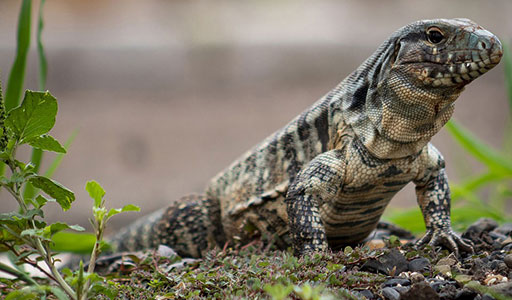
The Argentine black and white tegu is a large lizard that can grow up to four feet long. At first, they occurred naturally South America and existed in Florida only as pets; however, after escaping from the pet trade, they have now thoroughly established themselves in south Florida, particularly in the Hillsborough, Miami-Dade, and Charlotte Counties.
Argentine tegus are considered invasive in large part because they prey on Florida’s natural wildlife, including some endangered and protected species. For instance, they have been documented eating alligator eggs and disturbing crocodile nests in Florida, as well as consuming juvenile gopher tortoises, all of which are protected species.
As of April 29, 2021, tegus are not protected in Florida except by anti-cruelty law, and can therefore be humanely killed on private property, with landowner permission.
How to Help
According to Sarah Funck, coordinator of the Florida Fish and Wildlife Conservation Commission’s Nonnative Fish and Wildlife Program, there are a few ways people can help limit the damage from invasive species.
- Report sightings of nonnative species to the Exotic Species Hotline (888-IVEGOT1).
- Attend Iguana Technical Assistance public workshops to learn how to manage iguanas on their own property
- Don’t release exotic pets! Surrender exotic pets to the FWC’s Exotic Pet Amnesty Program
For individuals looking for more hands up volunteering:
- Join Python Patrol
- Sign up for Python Pick-up
- Clear reefs from lionfish with Reef Rangers
Invasive Animal Control in Southwest Florida
Each one of these invasive critters pose a unique danger to people and property. Do not try to control these animals unless you have proper training and experience.
If you’re having a problem with nuisance wildlife, give our team of experts at Trutech a call. We’ll work around your schedule to address the problem, so you can go back to enjoying all The Sunshine State has to offer.


